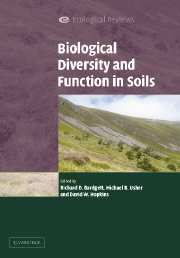Book contents
- Frontmatter
- Contents
- List of contributors
- Preface
- Acknowledgements
- PART I Introduction
- PART II The soil environment
- PART III Patterns and drivers of soil biodiversity
- 5 The use of model Pseudomonas fluorescens populations to study the causes and consequences of microbial diversity
- 6 Patterns and determinants of soil biological diversity
- 7 How plant communities influence decomposer communities
- 8 The balance between productivity and food web structure in soil ecosystems
- 9 Rhizosphere carbon flow: a driver of soil microbial diversity?
- PART IV Consequences of soil biodiversity
- PART V Applications of soil biodiversity
- PART VI Conclusion
- Index
- References
5 - The use of model Pseudomonas fluorescens populations to study the causes and consequences of microbial diversity
Published online by Cambridge University Press: 17 September 2009
- Frontmatter
- Contents
- List of contributors
- Preface
- Acknowledgements
- PART I Introduction
- PART II The soil environment
- PART III Patterns and drivers of soil biodiversity
- 5 The use of model Pseudomonas fluorescens populations to study the causes and consequences of microbial diversity
- 6 Patterns and determinants of soil biological diversity
- 7 How plant communities influence decomposer communities
- 8 The balance between productivity and food web structure in soil ecosystems
- 9 Rhizosphere carbon flow: a driver of soil microbial diversity?
- PART IV Consequences of soil biodiversity
- PART V Applications of soil biodiversity
- PART VI Conclusion
- Index
- References
Summary
SUMMARY
The microbial world is tremendously diverse. This fact was established in the early days of microbiology and is supported by ever increasing lists of 16S rDNA sequences and more recently by whole genome comparisons.
It is now time to divert attention from lists of organisms – even though these lists are undoubtedly incomplete – to questions such as the evolutionary and ecological causes of diversity; the ecological factors maintaining diversity and the significance of diversity in terms of ecosystem function.
Recognising the inherent difficulties of addressing these questions within the soil environment we have chosen to use experimental populations of bacteria maintained in simple laboratory environments. These populations have allowed us to reduce complexity to the point where insights into mechanistic processes become possible and have permitted rigorous empirical tests of fundamental ecological and evolutionary concepts.
Particularly significant has been clear demonstrations of the importance of ecological opportunity and competition in driving diversification of microbial populations. In addition, it has been possible to show how productivity, disturbance and predation can shape patterns of diversity by affecting the outcome of competition and how the observed patterns of diversity depend upon environmental complexity.
Most recently we have begun to explore the consequences of microbial diversity in terms of ecosystem properties and have been able to show, at a mechanistic level, how diversity, productivity and invasibility are connected.
Introduction
Recent technological advances have confirmed a long-held suspicion that soils are biologically diverse.
- Type
- Chapter
- Information
- Biological Diversity and Function in Soils , pp. 83 - 99Publisher: Cambridge University PressPrint publication year: 2005

